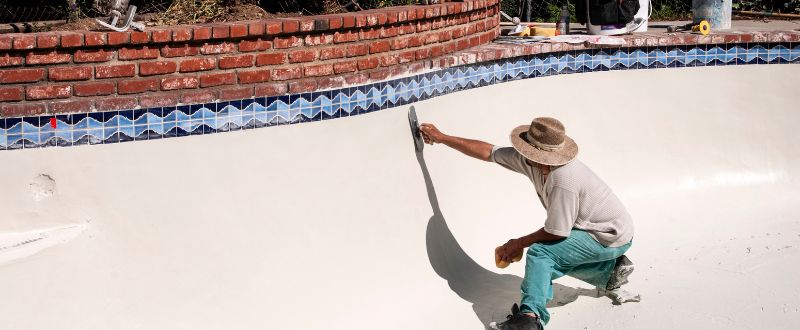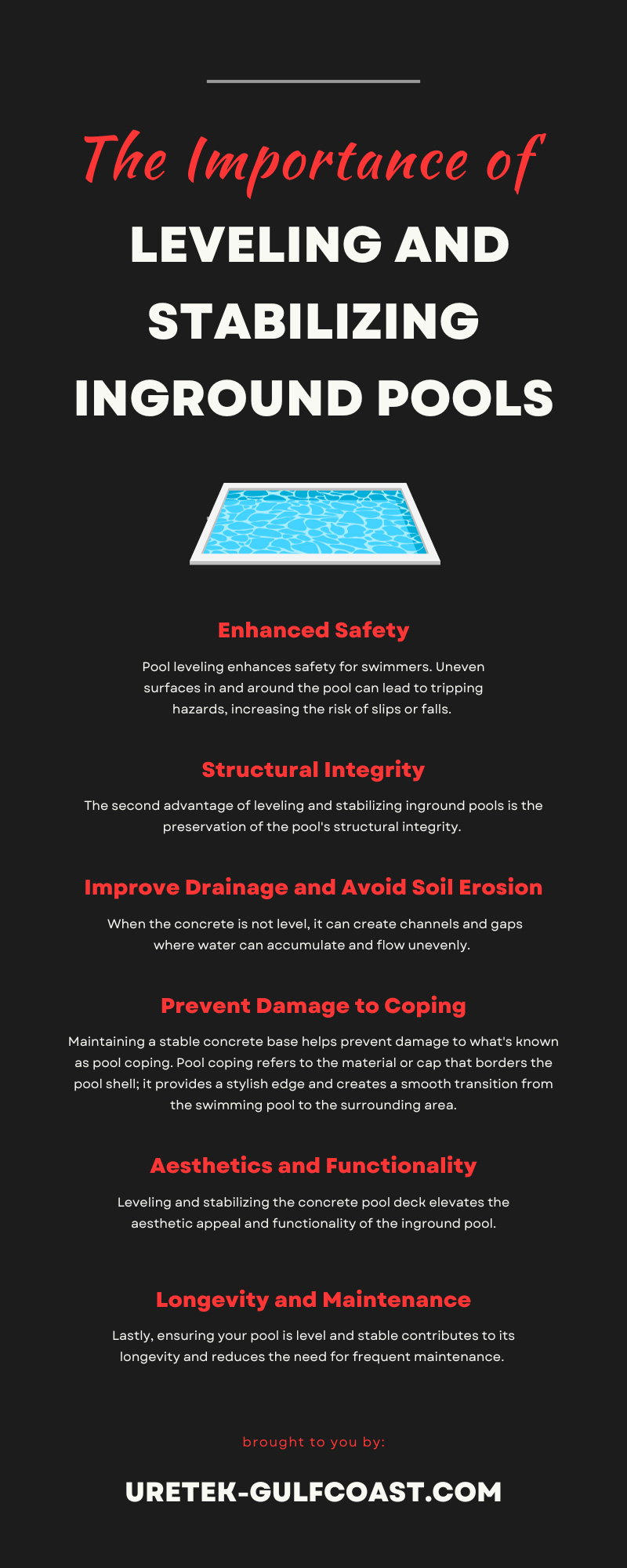A well-maintained inground pool creates a stunning outdoor oasis where your household and guests can relax. You have endless customization options for your pool. From choosing the size and shape to adding features like waterfalls or built-in seating areas, homeowners can create a pool that meets their specific needs.
Pool owners often overlook the importance of leveling and stabilizing inground pools. However, neglecting the pool deck and basin can cause cracks, an uneven waterline, and plumbing problems. Learn more about how concrete leveling can improve the functionality, appearance, and longevity of your swimming pool.
Enhanced Safety
Pool leveling enhances safety for swimmers. Uneven surfaces in and around the pool can lead to tripping hazards, increasing the risk of slips or falls. Sometimes, voids form under the plastic or fiberglass steps in the pool, causing the steps to flex or bow. In many cases, concrete leveling can fix this problem.
Uneven pool floors can create unpredictable depths, putting inexperienced swimmers in potential danger. A level surface facilitates accurate water depth markings. Maintaining the concrete helps minimize these risks and creates a safer environment for people in and around the pool.
Keep Pool Skimmers Effective
Beyond the immediate reduction of slip hazards and unpredictable depths, concrete leveling provides more subtle safety advantages. For example, pool skimmers draw water from the surface into the filtration system. An unlevel or sinking pool can create an uneven waterline that prevents skimmers from receiving adequate water. Keep the waterline even to improve the pool’s cleanliness and prevent filtration system problems.
Structural Integrity
The second advantage of leveling and stabilizing inground pools is the preservation of the pool’s structural integrity. When the pool’s foundation shifts, the weight and pressure of the water distribute unevenly, putting more stress on some sections of the pool walls and floor.
Uneven surfaces can cause cracks and weakening of the structure, leading to damage that may require expensive repairs. Expanding polyurethane foam fills voids and stabilizes concrete, improving weight distribution and preventing more settling.
A level base also plays a critical role in preventing leaks. Uneven surfaces can lead to gaps or breaches in the pool liner, causing water to seep out. These leaks not only waste water but can also undermine the surrounding soil or concrete, leading to further instability. Maintaining a stable base for your inground pool is paramount for its structural integrity, reducing the likelihood of costly repairs or replacement in the long run.
Improve Drainage and Avoid Soil Erosion
Uneven concrete can also cause soil erosion that further compromises the pool and harms surrounding vegetation. When the concrete is not level, it can create channels and gaps where water can accumulate and flow unevenly. As water moves across the uneven surface, it gains momentum and power, eroding the surrounding soil.
Water that gathers in low-lying areas of the uneven concrete exacerbates the erosion process. As water accumulates, it seeps into the soil, saturating it and weakening its structure. Over time, this constant saturation and displacement of soil particles can lead to erosion, causing the soil to be washed away.
Unstable concrete can divert water in unpredictable directions. This can result in concentrated flows that further erode the soil in certain areas while leaving others untouched. This uneven distribution of water can lead to localized erosion, creating gullies or trenches in the surrounding soil.
Concrete pool deck lifting improves the stability and level of the deck, preventing slip hazards and damage caused by standing water. Experienced technicians can inject polyurethane foam to fill voids, lift the concrete, and improve the weak soil’s load-bearing capacity.
Prevent Damage to Coping
Maintaining a stable concrete base helps prevent damage to what’s known as pool coping. Pool coping refers to the material or cap that borders the pool shell; it provides a stylish edge and creates a smooth transition from the swimming pool to the surrounding area.
Pool coping plays a crucial role in directing water away from the pool and toward the surrounding drains, reducing the risk of water damage to the pool structure and surrounding areas. Pool coping protects the pool shell from debris, but coping can only adhere to a flat concrete surface.
When the underlying concrete base of your pool is uneven, it can cause stress and cracking to the pool coping due to uneven pressure distribution. Damaged coping can allow water and debris to infiltrate the pool shell, potentially causing substantial harm.
Aesthetics and Functionality
Leveling and stabilizing the concrete pool deck elevates the aesthetic appeal and functionality of the inground pool. Uneven concrete can result in an unappealing appearance, with odd dips and rises disrupting the deck’s uniformity. This irregular look diminishes the overall attractiveness of the pool area and creates a safety risk.
On the contrary, a level and stable pool deck creates a seamless, harmonious look, enhancing the overall landscape design. The uniform surface allows for more precise and creative placement of pool furniture and outdoor decor, which further contributes to the beauty of your outdoor space.
A stabilized concrete pool deck ensures comfort and ease of movement for swimmers and sunbathers alike. Stabilizing minimizes unexpected bumps or depressions that disrupt activities or make walking uncomfortable. Moreover, the more level the surface, the more securely the deck can hold pool accessories like ladders and handrails, contributing to both safety and convenience.
Longevity and Maintenance
Lastly, ensuring your pool is level and stable contributes to its longevity and reduces the need for frequent maintenance. A pool with a solid foundation will endure the test of time and require less attention to repairs and upkeep, saving homeowners time and money in the long run.
When the concrete base of the pool is level, it supports the weight of the water evenly, minimizing unnecessary stress on any single section of the pool. This even distribution of weight prevents the development of cracks and structural weaknesses that could otherwise occur over time in pools with uneven surfaces.
Concrete pool repair will yield benefits in safety, structural integrity, optimal water drainage, aesthetics, and longevity. For professional concrete pool repairs, contact URETEK ICR Gulf Coast. Our concrete stabilizing services cause minimal disruptions and do not require heavy machinery. Contact us to discuss efficient concrete stabilizing for your swimming pool.


